My own created strains of guppies and endlers
Besides breeding with existing strains (common or rare), I also line breed with natural mutations and hybrids. The focus is to line breed in order to develop a new strain of fish. And in this case specifically of guppies (for endlers are also guppies as I've mentioned in the sections "wild guppy" and "endler")...
Some of them have already been sold by me at events or through forums. But I do like to make an announcement at this point as well. Basically, I won't be selling these strains for a certain time of period in order to stabilize these strains for a bit more. Unfortunately, there are certain individuals who like to run away with these fish (happened before with other strains) and renamed them in order to present them as their very own...
Therefore, I am only publishing these strains in order to state that these fish are hybridized by me and when the base has been a natural mutation, I'll state that as well that they were born from my own fish. In both cases I've created a new strain or (depending on the strain) strains that I'm still working on them.
I also want to put out here that when one is dealing with a hybrid strain no matter if it's considered a true breeding strain, there's always a chance that a phenotype of one of the ancestors will show up again. It just remains a hybrid strain!
Tiger hybrid blue diamond
This is my so-called tiger hybrid blue diamond endler. It started off with a natural mutation in 2012 within my group of tiger hybrids. So, no influence of other strains or even a fancy guppy. One male developed the blue colour on his body. It took about 4 weeks before more males were developing this colour instead of the golden body.
It does look reasonable similar to the regular tiger hybrid but the tails are more spear tail-like. I've put them in a separate tank with sisters to create a solid strain out of them. The F1 is already a fact and the blue is already appearing again.

I do have to admit that some resemblance to Poecilia reticulata is a clear thing despite of the fact that I didn't add any guppy blood to it. I do think it's because in the tiger hybrid strain itself is already guppy blood present which might explain the guppy resemblance.
Red panther hybrid
Another mutation which occurred within my group of tiger hybrids back in 2011, is my so-called red panther hybrid. I call it a panther hybrid instead of tiger hybrid simply becoz' of the way the tiger pattern has changed into a panther pattern on the males.

It was a nice surprise that this mutation occurred and they started off becoming pink on a bronze metallic base. Interbreeding with their sisters showed more red in the new males' bodies.. The current males are deep red all over their bodies.
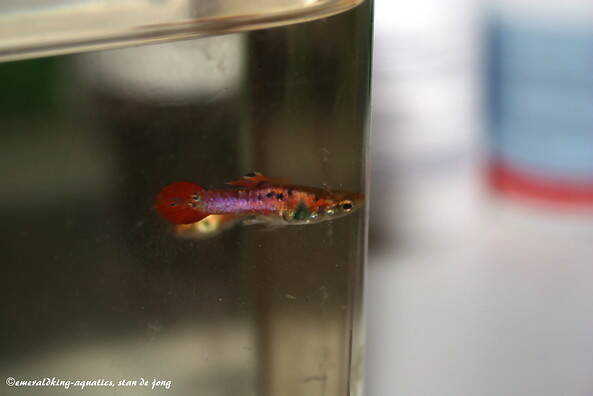

Back in 2012, I've sold a certain amount of them on the vivaristic events. Some like to call them pink panther hybrid or even pink tiger becoz' it does have a certain pinkish appearance but all my red panthers turn real red in the end. If you won't select those male offspring the more prink they will become and the red will fade.
Nowadays, a lot of other breeders have accomplished the same strain but added red scarlet (aka chili endler) blood to it. I didn't! For tiger endlers already do have a red-gene in them which you only have to mark on the outside.
Lotus tiger hybrid
In October 2015 I've started another project. My goal was to create a tiger hybrid strain which showed a lot more black markings. It took until summer 2016 to have a solid base for this new strain. Also the zebrinus markings got less and some males were only showing them on the lower part of both sides. I'm quite optimistic about this strain to develop more and more steadier.
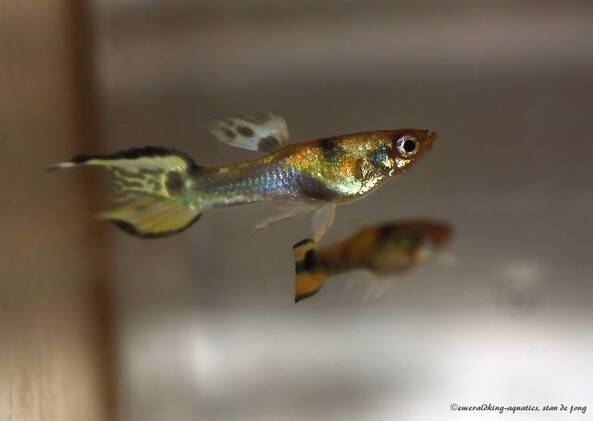
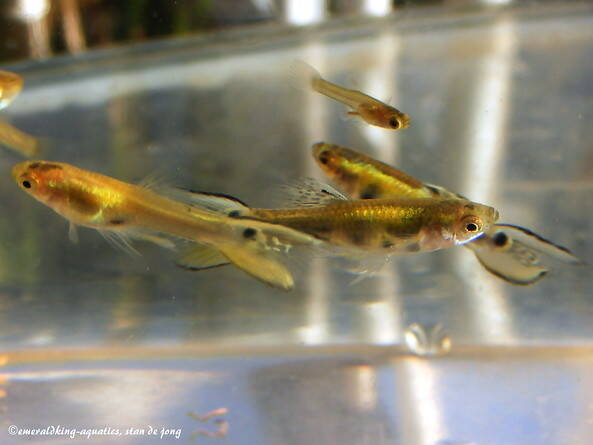
Once the males color up some will have a silvery chest but most will develop a golden chest.
In April 2016 I've split a small group of males of the colony and mixed those with blonde females. This resulted in the golden equivalent of the grey based ones. But these males won't show any black. Neither do the blonde female offspring unlike the gray females (which have some black markings at the start of the caudal fin).

The blonde based ones are as attractive as the gray based ones. But those blondes do show more zebrinus markings as the gray do.

In some way there's still a resemblance with the regular tiger hybrid endler. But way less zebrinus markings which are replaced by black markings.
Golden red tiger
In Summer 2019, I've started my project to create a red/pink tiger hybrid on a golden base. In March 2020, I've got them real stable in passing on the traits. They're exactly like the grey based ones when it comes to pattern and coloration. Maintenance is also the same.
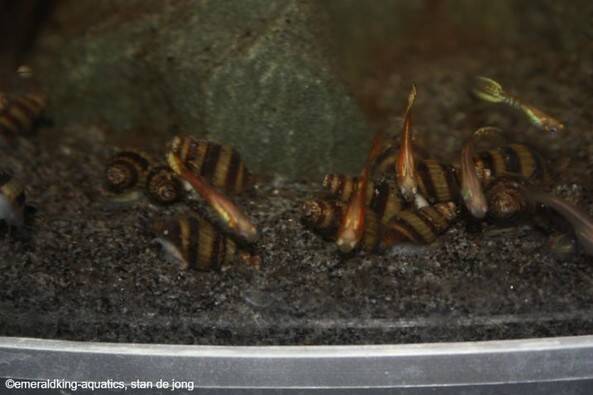
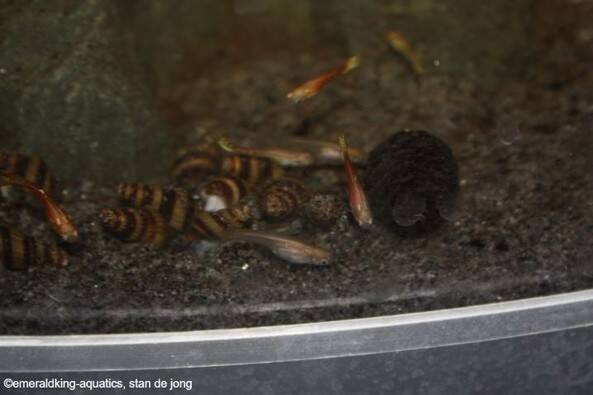

Flare red scarlet
Mid last year (2011), fry was born in my group of red scarlets. Partially grey and partially blond. This group have been kept pure. So never been mixed with other strains. A mutation occurred and I've been separating all blondes within two weeks from the grey ones. I was curious how the blond ones would develop. It didn't take too long before more blond offspring occurred and again I've put them together with all the blond fry which were born before. I also added extra blonde virgin endler hybrid females to the colony. And I have developed them to a pure breeding strain of blonde red scarlets.
Note: Red scarlet (chili) endler is a hybrid strain which does have guppy influence. It could be that in that guppy line a blonde gene was present even though the used guppies could've been phenotypical gray.

While letting them mature, it was obvious that all males were developing like normal red scarlets. But instead of a grey base, they started off with a blonde base. The black bar which a regular male red scarlet has was replaced by a white-yellow bar. And there are specimens which are missing out on a bar on both sides of the body. This strain reproduces pure and seems very prolific.

Besides red scarlet bodies, also magenta bodies are occurring. Becoz' of the blonde base, the magenta look appears a bit more yellow-pink. I've named this strain flare (= blond) red scarlet. In my point of view a very logical name to give them...
Although, the intend was to create males with just slight double sword s the way it was with the regular grey based ones, some males do develop a closed caudal fin.
I've noticed that this strain which I've called flare red scarlet is also called "red flare" by others. Just like more strains, people tend to call them differently after a while. This change of name is something we can't avoid as it seems.
Crimson red scarlet
Another mutation of my red scarlets is my so-called crimson red scarlet. This strain has almost the same appearance like the red scarlet but more black markings are visible on the males' bodies. In 2010 I've started selecting them from my regular red scarlet (aka chili endlers) strain and mixed more tuxedo blood into it. This resulted in more black markings on te body of all males.

I'm so proud that this strain is developing the way I would like to see it. The name "Crimson" relates to a red colour but also to ancient time when pirates were still conquering the oceans. The colors red and black always cross my mind when I think of pirates. It's also a rebellious thing and in some way this type of red scarlet endler reminds me of that. That's why I named this strain "crimson red scarlet".
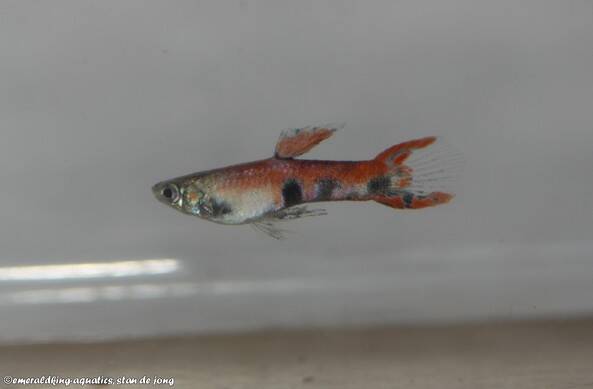
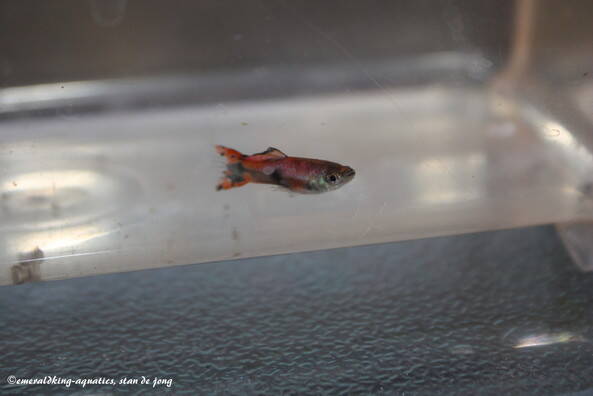
Just like the regular red scarlet, also within this strain there are magenta males.
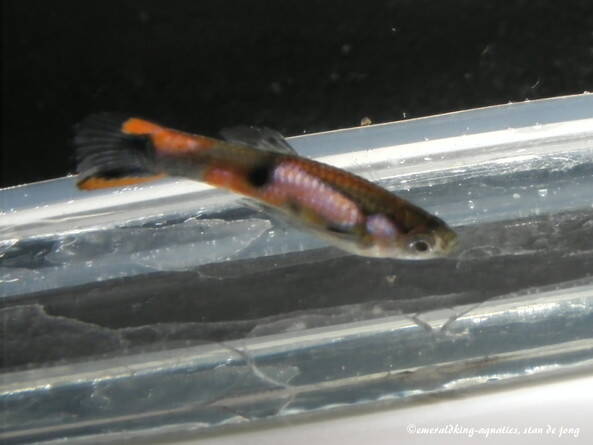

All the males have a standard black spot in the tail. Also the black bar is present but not as clear as the regular red scarlet. I do have to admit that I love this version much better than the regular red scarlet.
Like the regular red scarlet, both the Störzbach-gene and the magenta-gene are very present. So, you'll find both characteristics in a certain number of the male offspring.
Overhere a picture of how those males started off back in 2010.

Just like some other strains of mine, these are distributed for some years now and they go by other names as well these days. In Germany they're also called "Schwarzbunter scarlet" and some call them "Spotted red scarlet". And for sure also other breeders have created a similar strain for it's not that hard to create this.
Blonde yellow top sword endlers
In spring 2018, I've started to create the blonde version of the Cumana yellow top sword (YTS) endlers. It wasn't that hard to get the project stable. Using blonde virgin female hybrids did already the job. Not a single throw back has occurred ever since.
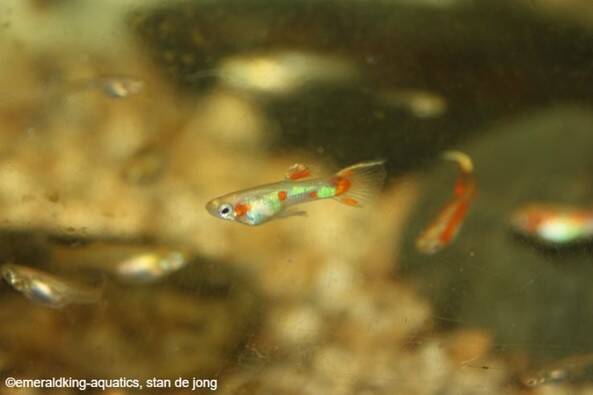
It's a nice looking equivalent of the original Cumana yellow top sword endler. But in this case we're dealing with a hybrid strain.
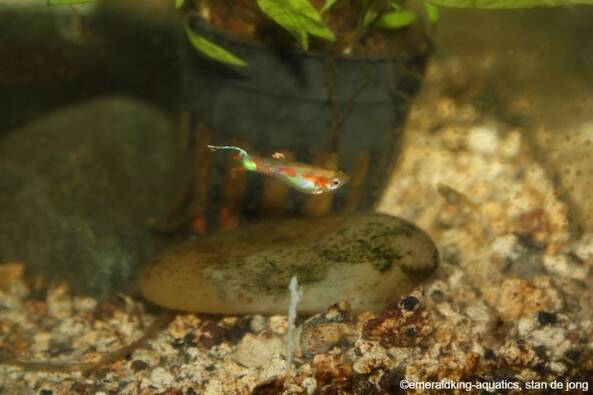
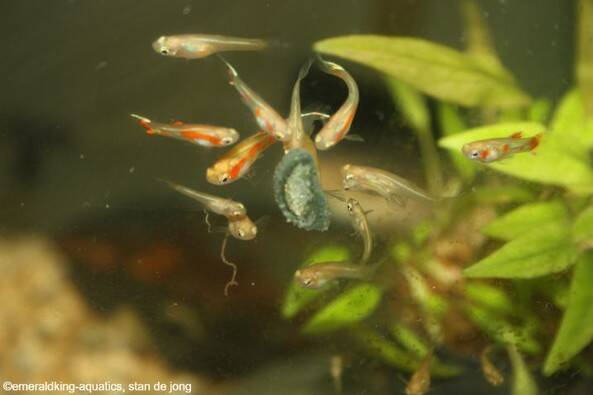
Flare snakeskin
A strain of snakeskin hybrids with a blonde base was realized this year (2012) as well. These blonde snakeskins are the results of intercrossing a male snakeskin endler x a female flare (blonde) endler. First results was a whole bunch of regular flare endlers and just one male blonde snakeskin. This male was used to cross with certain sisters and about 40% was regular flare endlers (recognizable males) the other part (of the males) were blonde snakeskins. Now, the new offspring of all the blonde snakeskin males and their sisters are blonde snakeskins.

The black bar which is typical for a male snakeskin endler has turned into an orange bar on the flare snakeskin endler's chest.
Ever since 2014 I do breed them with more red markings on both shoulder and tail.
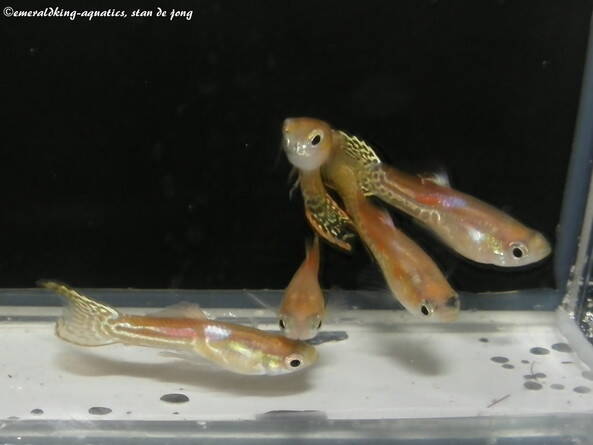
In January 2016 also some albino snakeskins were born but within the whole line they turned out recessive in comparison to the black eyed ones. Also less red markings were present on the albinos.
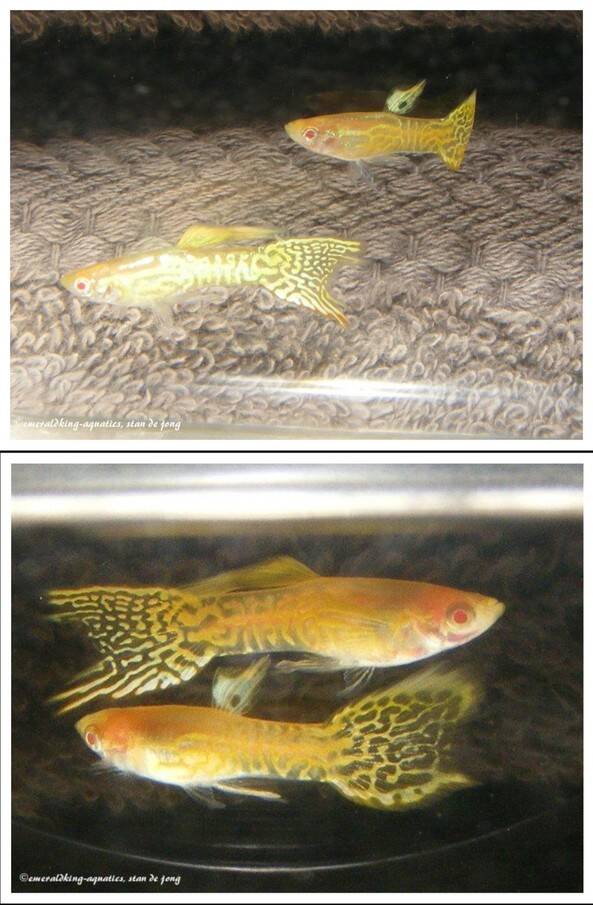
Black hat cobra endler
In October 2019, I've started to set up a project to create a cobra endler that would look different than the already existing cobra endler hybrid strain.

What I had in mind was to keep the same body shape but the black bar mark should not be present on both sides of the chest. But some other kind of black mark should be present on the body. At some point I thought that a black mark on the head would be a nice idea. So, I selected a few male cobra short double sword guppies and some virgin Santa Maria bleeding heart endler hybrid females. I knew that the black gene in the females was dominant.
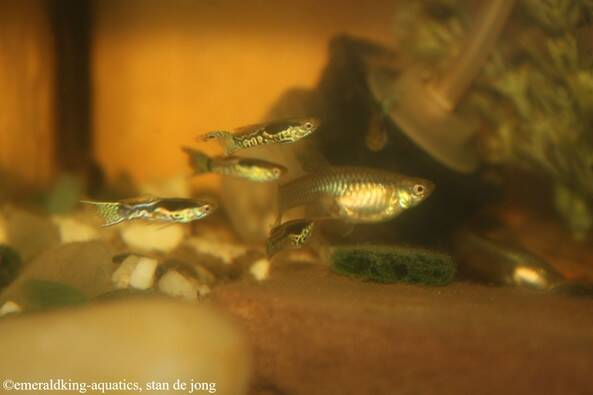

In the F2, I already had the desired males. But I just had to select the right males to work on that black mark on the head. The following two generations after that attempt, I had the desired males with the black mark on the head. And it bred true from that moment on. Well, how I named this strain isn't very surprising: Black hat cobra endler.
Although the name "Black hat" is also used for the wild Cumana orchid endler, there's no orchid endler influence in this line.

Black cobra endler
At the end of 2019 I've started my project of black cobra endlers. My goal was to create a black bodied endler hybrid with cobra pattern in the finnage and optionally cobra pattern on the chest.
Using a male cobra endler (hybrid strain) and a number of virgin female tuxedo endlers (hybrid strain) as the F0 base. The tuxedo females carry the dominant moscow trait. Already in the F1, I had my first number of males that looked a bit like I had planned. After culling a and selecting the right males., I let them grow up separately from the females.

A number of the F1 daughters were backcrossed to the father. All F2 females of the cross father x daughters were crossed to the F1 males that grew up separately. The male offspring of the of the father x F1 daughters were crossed to the daughters of the F1 males x the F1 of the cross father and daughters. Only the most intense black bodied males were used to all left females (that weren't used of three generations. After a bit over one year, they breed true.
There are males with a snake chest and males with a black bar on a black body and cobra pattern in their finnage. All females however are all dark bodied with no pattern in their finnage with a small number of exception.
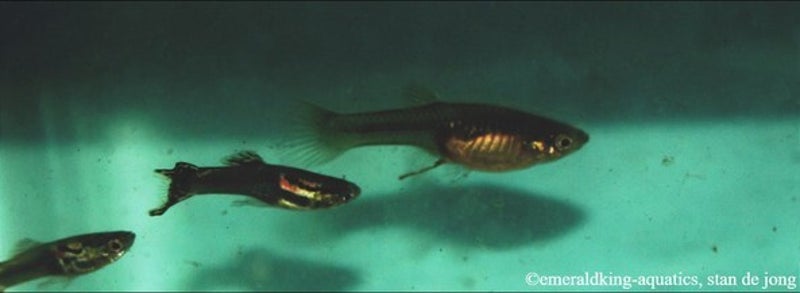
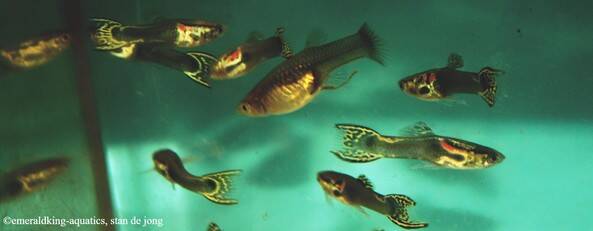

Tuxedo silverado
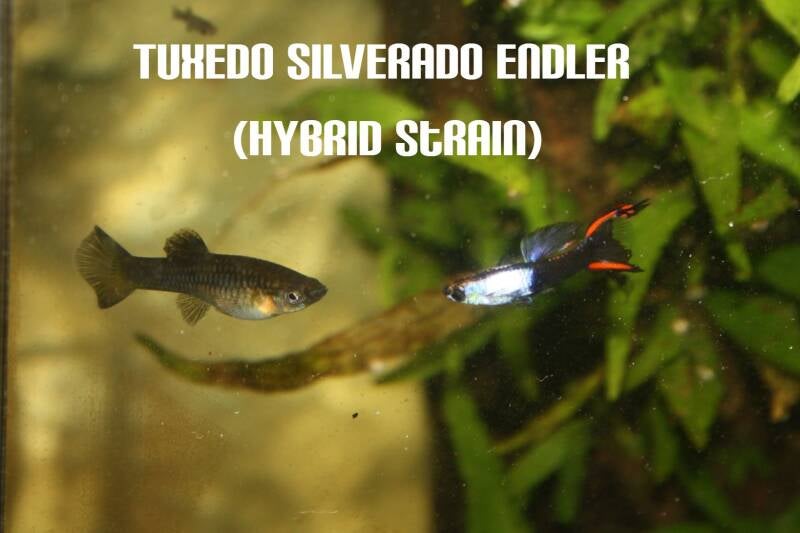
In 2023 I've decided to create my own version of a tuxedo silverado hybrid endler strain. In this case it was important to use black moscow guppies to keep the black bodied base. The plan was to create a phenotypicsa shaped endler body with a black color and a silvery shoulder and head. It took me about 4 generations to get to the result as desired..
The first rough version of my intended plan resulted in males with the phenotype showed in the photo below.

The red double swords were already there at that stage. And so was the silvery shouder and head. But phenotypically in shape it was still more a guppy breeding form than the bodyshape of an endler. So, my next step was to refine it all. This was succeeded in early 2024. The males were smaller and had better red swords. Males start off with developing white spots on the outer caudal fin rays which are slowly covered by red swords. The dorsal is completely black and is steady inherited by the moscow gene. Also the green that the rough version of the males had has disappeared. The green came from the Vienna emerald DS guppy influence.
The current males look like the males shown below.

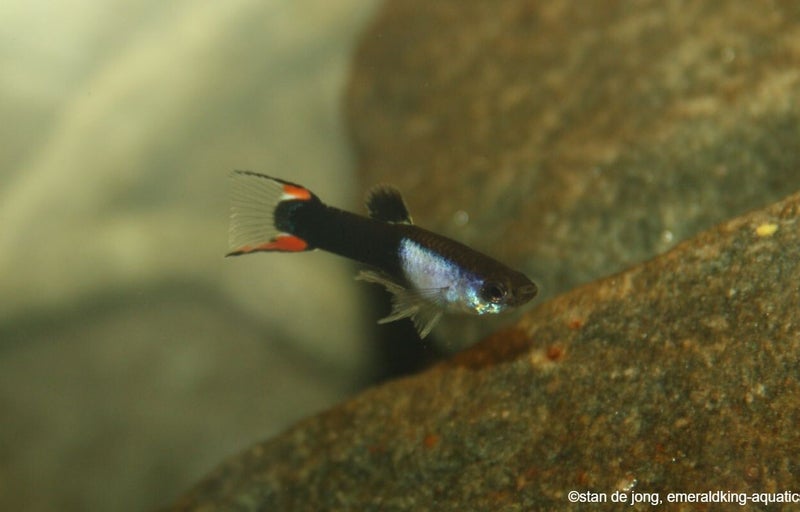
Phenotypically, these males are similar to an endler bodyshape. The females however are dark with no particular pattern nor coloration. Some female specimens have a black crescent in the tail close to the caudal penducle. But after four generations after my start of the project, this new strain breeds completely true.
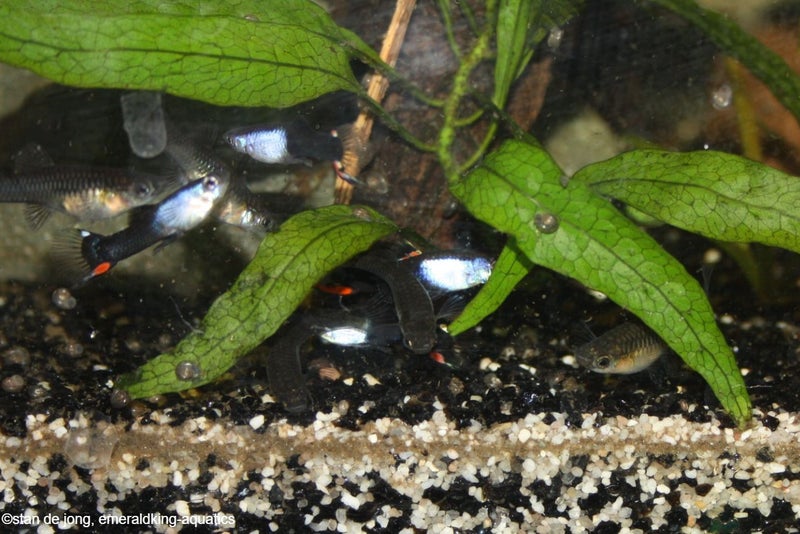

Above: Multiple males gathering under some jave fern leaves.
Above: Multiple females gathering.
Unlike the normal tuxedo endler hyrbid strain (black flame endler), no males will have red dorsals. They're as prolific as any other guppy breed and they're quite hardy. The hardiness was also one of the things I was aiming at when I planned my project.
Neon green saddleback
The neon green saddleback endler is a an endler variety I came up with in February 2019. I use to keep Cumana limegreen endlers for a long time. But the problem with those limegreens was that I had to cull each generation to keep the focus on the green. Otherwise, orange and/or red would become dominant on the body of the males. After the limegreens were moved to another owner, I just couldn't get rid of the idea of green endlers. So, I decided to start a project to create a green endler that wouldn't show any orange or red on the body.
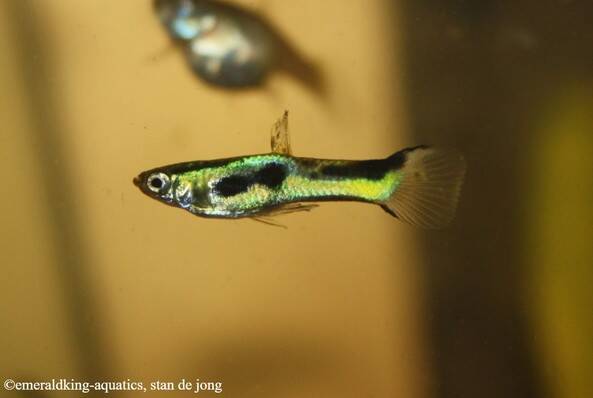
I chose the black bar endler to work with. To suppress the red color, I've used Asian blau guppies as breeding partners . So, this new strain is a hybrid strain. It took me 2 generations to get the first good results.


And yes, after those two generations, I had only 10% male offspring that still developed some red or orange on their flanks. But after selecting the right males, ever since the third generation, all male offspring only showed green on their body with black pattern.
There are two kinds of males: greens with a black bar on the shoulder and greens with a dot on the shoulder.
Blue orchid
In order to create another version of the orchid endler, I was brainstorming for a while. But in some way my favorite colour "blue" stayed in my head. So, I thought: how nice would it be to create a blue orchid endler?
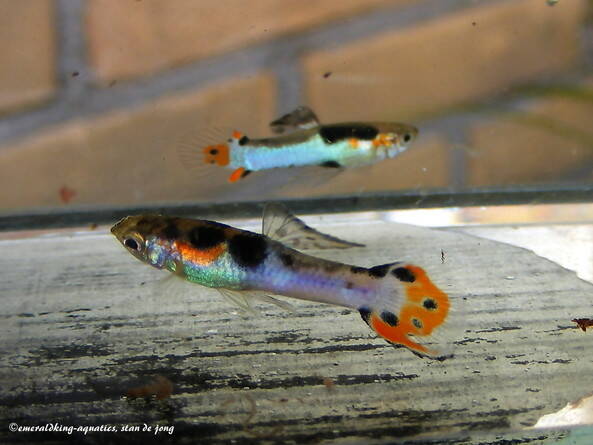
So, in fall 2013 I've started to set up a special tank to accomplish this goal. The results are already a fact and I've got a nice group of blue orchids swimming back home.
The bottom swords differ at each individual male regarding the coloration. Some have blue, white or red bottom swords.

All males have the black hat which is typical to the original Orchid endler. The slender body shape has been respected the way it is with the N-class version. A real beauty of an orchid endler...

Leopard
Back in 2013, I've started a new project. Wanted to create a strain which looked a bit like snakeskin but with a different touch. I've started off using some of my yellow top sword endlers by outcrossing them with blond snakeskin double sword guppies (so, no endlers). It took a while to select the right offspring and went forward with those.
Below a picture of some which was taken by Tieme de Vries. He's just like me a co-host at The Guppy Book on Facebook (since late 2015). They occur with and without red markings.
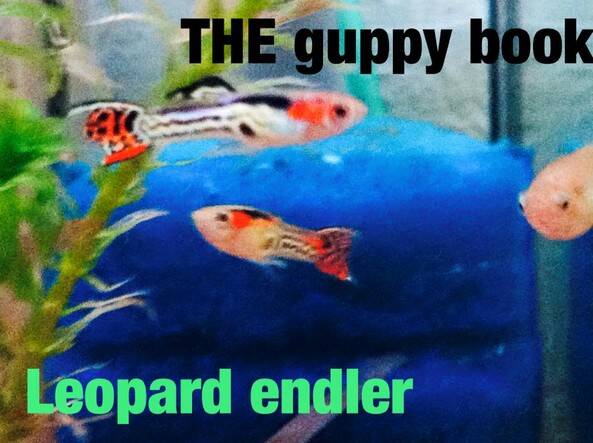
Besides the grey based ones also blond based ones have occurred.
Further on, this strain is very prolific and quite hardy. A nice looking hybrid endler which looks a bit different from the regular snakeskin endler.
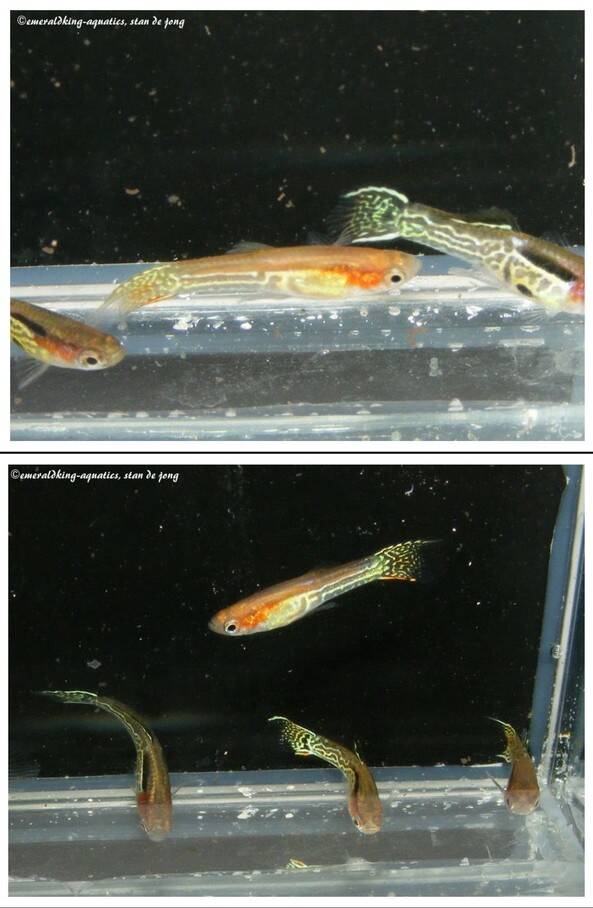
Pineapple endler.
In spring 2020 I've started to create the Pineapple endler. This is of course also a hybrid strain. It does look a bit similar to the yellow saddleback endler hybrid but is lacking the black saddle and this lighter.

The idea was to create a yellow-golden endler hybrid with a lack of black pattern. But some accents should be present on the endler hybrid. The male's got a yellow body with an orange line on the shoulder and a very thin line on top of the body from head till tail. The female is translucent golden.
I myself think that the yellow-gold of the male is pretty vibrant. It's a classy looking hybrid.
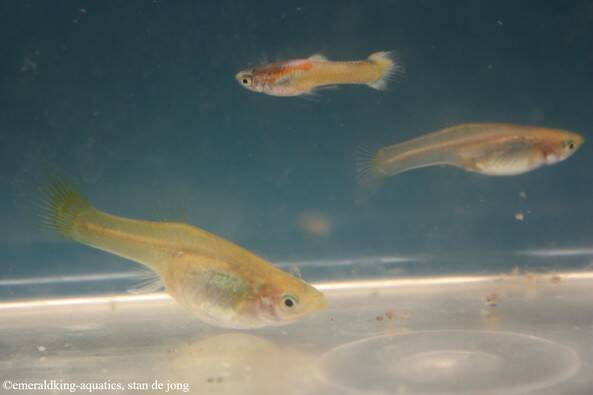
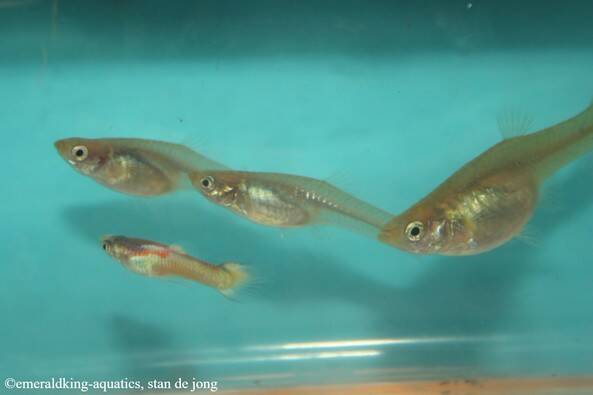
White pearl
Since fall 2013 I've started a new project to create a white endler.
Using culled flare red scarlets of which the red body colour became more faded because of the intensity of the Störzbach gene and the magenta gene, I've created the white endler version.

I've bred this strain forward till somewhere end 2015. They're born blonde based. The female remains blonde. Unfortunately, this specific strain collapsed and I haven't regained the strain again.
.
Orange peacock DS
In spring 2015 I've initiated a project to create a shorter bodied guppy strain with orange fins, double swords and a peacock on the shoulder and on the caudal.

No endler influence, btw... But one of the breeders was the Rio Casanay wildguppy. Also a Ginga strain (Gingas have wildguppy blood as well and no endler influence) and a filigree spadetail guppy. A fourth bloodline remains a secret to others.
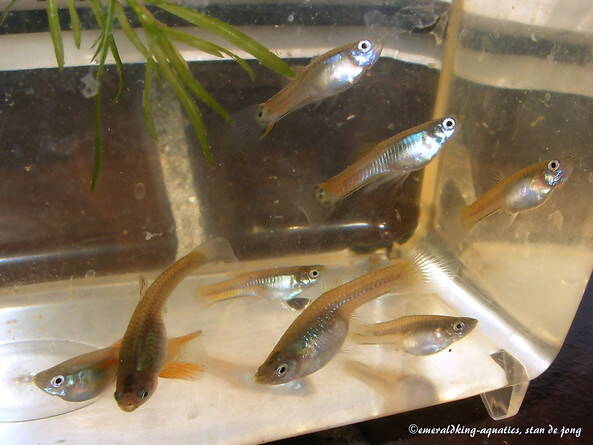
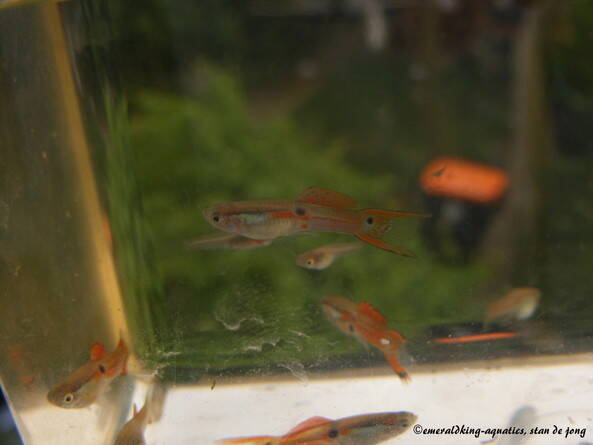
It took me about 18 months to get them to breed steady and pure.
Moscow lace
In summer 2015 I've started to create the moscow lace. I purchased a small group of spotted lace double swords early spring 2015. Some male offspring of this group developed flagtails. In summer 2015 I've selected a couple of male flagtails and put them together with some virgin black moscow females.
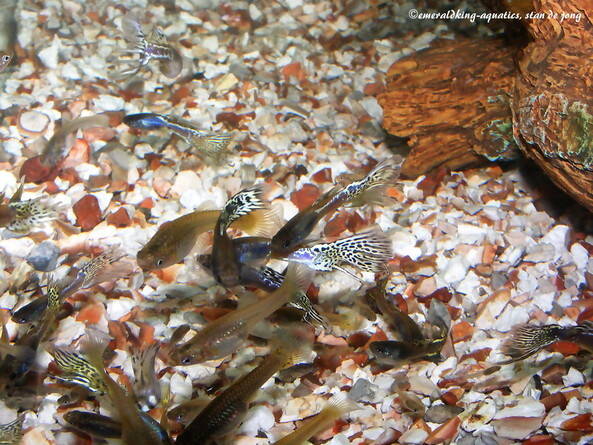
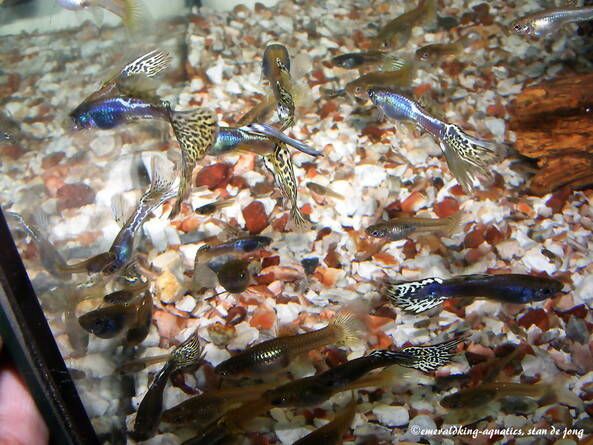
The males body shows black (bluish). Some better than the other. With lace pattern in the dorsal and caudal. females however showed a yellowish coloration in their tail and some on their caudal penducle. And at some point there were females developing with a bit of lace pattern in their fins.
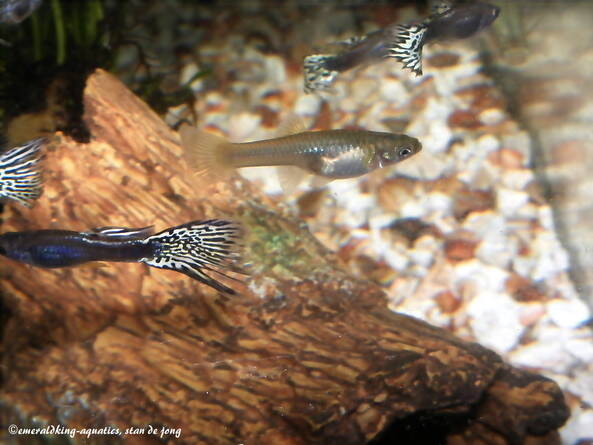
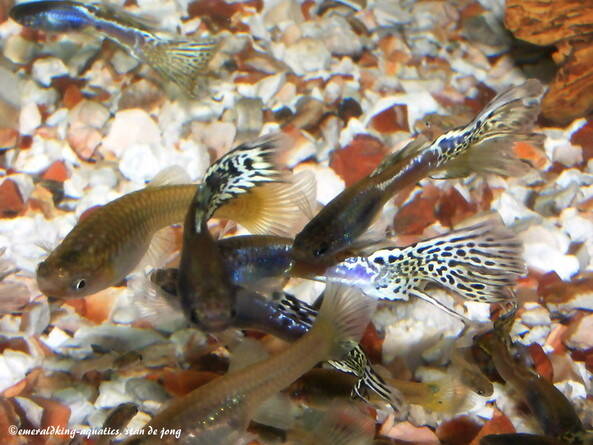
These ain't metal heads. Because also their bodies have the moscow trait shown. Real metal heads (also derived from moscow guppies) have the moscow trait only shown on the head.
Filigree top sword blonde (hybrid)
I use to have filigree top sword guppies (both grey and blonde based). First ones I've purchased from Peter and Astrid Raschke.
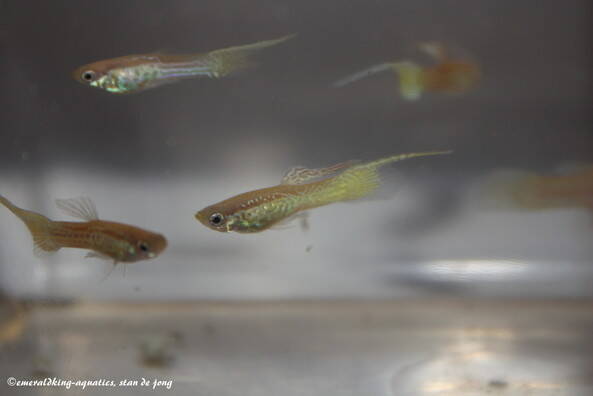
At some point I ran out of them and just one blonde male was left. I couldn't find new ones in my neighbourhood. And for sure an lfs wouldn't be selling them. So, I had to become creative. I knew that the females of the flare red scarlets (endler hybrids) were recessive for the genes of their own strain. So, I used virgin females of the flare red scarlets. The males of the F1, showed all the filigree pattern but no top sword yet. I've crossed a number of the daughters back to the father. The male offspring of those crosses were a bit smaller and showed a slight thin top sword. The body shape showed more endler characteristics at that point. These males were crossed to the females of the F1 that were kept separate from the others. The male offspring of that crossing looked exactly like the original male used. And the top swords they develop are (a bit thinner than the original) as long as the guppy version. Even the body length is like the original guppy version. Thusfar, they do breed true...

It's a nice strain and a good alternative for the original filigree top sword guppy.

